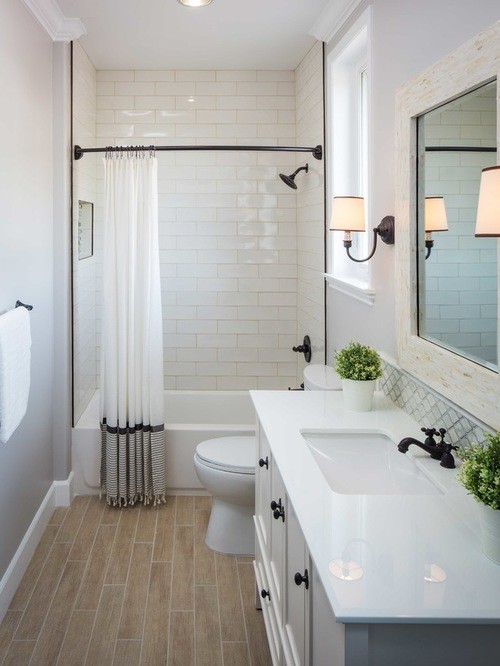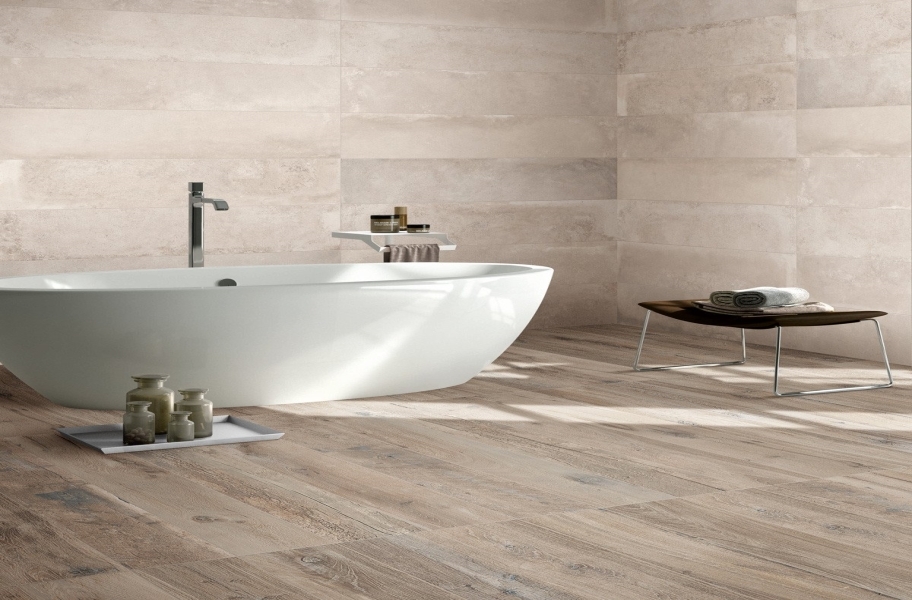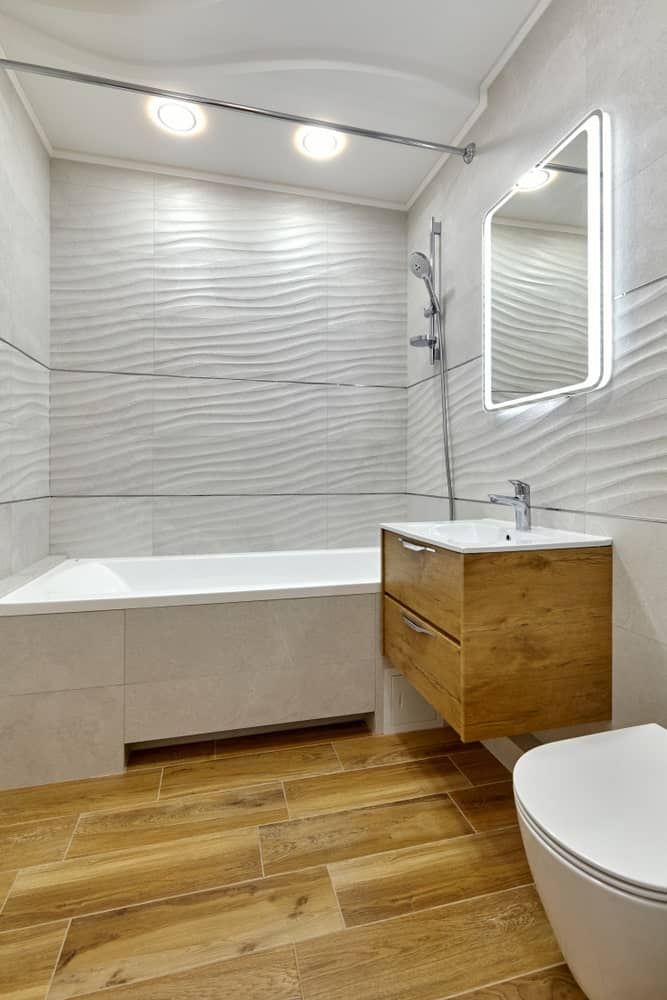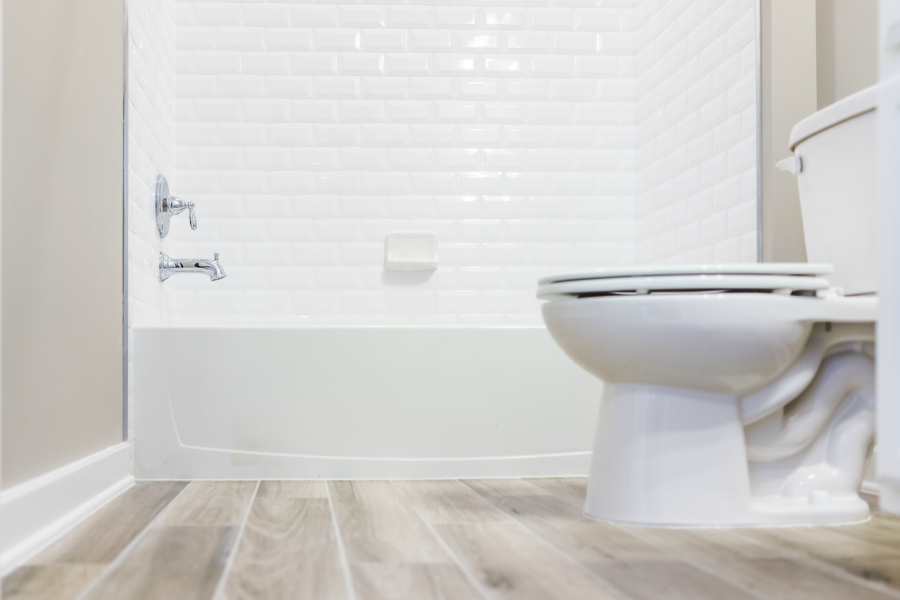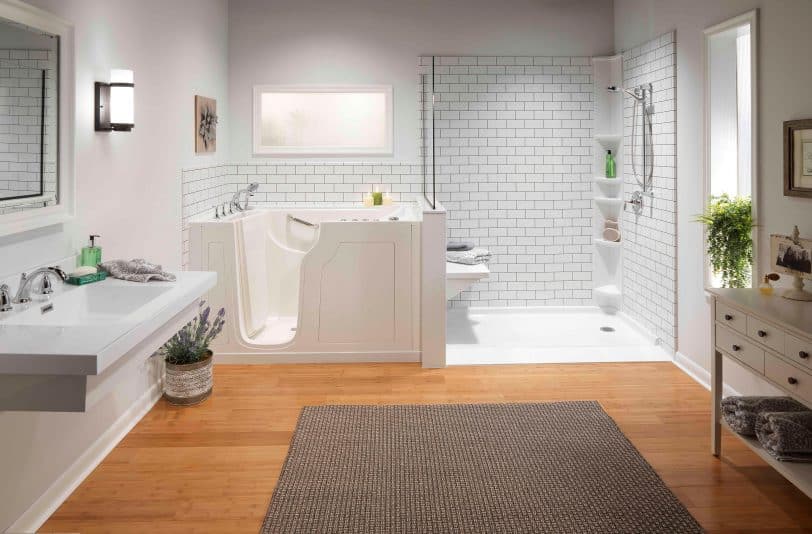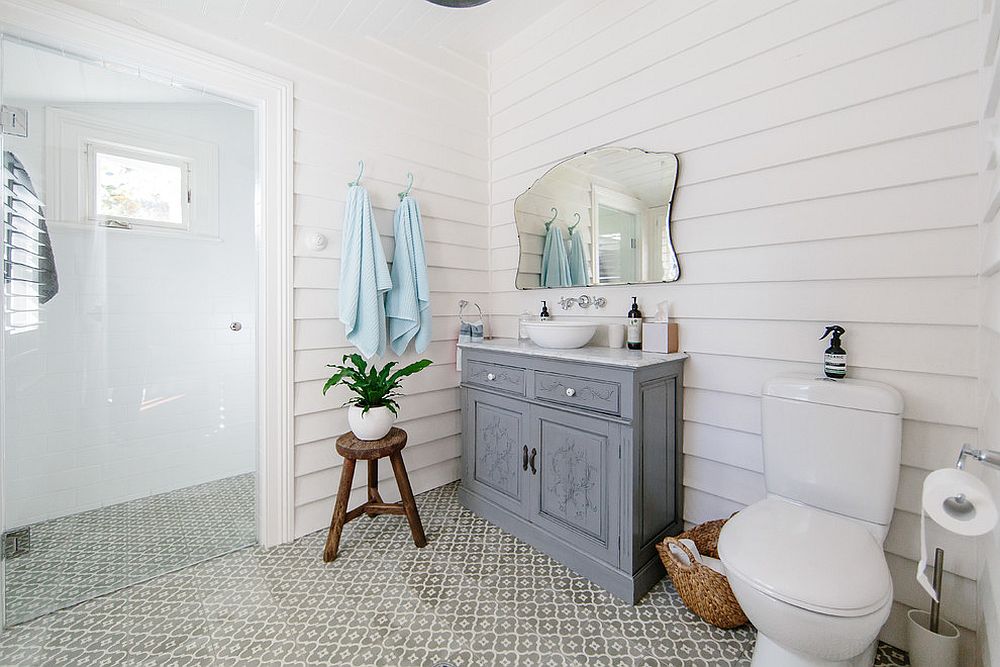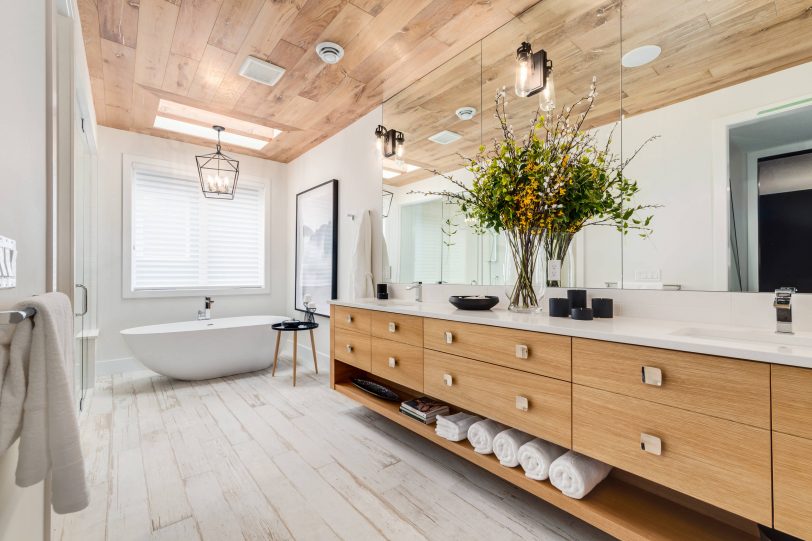Why Choose White Wood Flooring for Your Bathroom?
Aesthetic Appeal
White wood flooring adds a touch of elegance and sophistication to any bathroom. Its light, airy appearance can make a space feel larger and more open, which is especially beneficial in smaller bathrooms. The clean lines and neutral tone complement various design styles, from modern minimalist to rustic farmhouse.
Versatility in Design
White wood floors offer incredible versatility. They act as a neutral canvas, allowing you to play with colors and textures in other elements of the bathroom, such as walls, fixtures, and décor. This adaptability means you can easily update the bathroom’s look without replacing the flooring, making it a timeless investment.
Brightening the Space
Bathrooms often suffer from limited natural light. White wood flooring reflects light, enhancing the brightness of the space. This reflective quality not only makes the bathroom appear more inviting but also contributes to a sense of cleanliness and freshness, which is essential in a bathroom environment.
Creating a Spa-Like Atmosphere
White wood flooring can transform your bathroom into a serene, spa-like retreat. Its calming effect can enhance relaxation, making your bathroom a peaceful escape from the stresses of daily life. Pairing white wood floors with other natural elements like plants or stone can further amplify this tranquil ambiance.
Increasing Home Value
Investing in high-quality white wood flooring for your bathroom can boost your home’s resale value. Potential buyers often seek updated, stylish bathrooms, and the addition of white wood flooring can be a significant selling point. It signals a well-maintained and thoughtfully designed home.
Durability and Longevity
Modern white wood flooring options, such as engineered wood and certain treated natural woods, offer durability that can withstand the moisture and humidity of a bathroom environment. When properly sealed and maintained, these floors can last for years, making them a practical choice for long-term use.

Types of White Wood Flooring Suitable for Bathrooms
Engineered Wood Flooring
Engineered wood is an excellent option for bathrooms because it consists of a real wood veneer on top of a plywood base, which provides better resistance to moisture than solid wood. This type of flooring combines the beauty of real wood with improved stability, making it less susceptible to warping.
Luxury Vinyl Plank (LVP) Flooring
LVP flooring mimics the appearance of white wood but is made from durable, water-resistant vinyl. It’s a cost-effective alternative that offers easy maintenance and installation. Luxury vinyl planks are also highly resilient to moisture and temperature changes, making them ideal for bathroom use.
Laminate Flooring
Laminate flooring features a photographic layer that can imitate white wood, covered by a protective overlay. Modern laminates are highly resistant to scratches and moisture, though they may not be as durable as engineered wood or LVP. They provide a budget-friendly option with a realistic wood look.
Whitewashed Hardwood
Whitewashed hardwoods retain the natural texture and grain of wood but have a lighter, weathered appearance. While not as water-resistant as engineered wood, they can be used in bathrooms with proper sealing and maintenance. They offer a rustic, beachy aesthetic that can be very appealing.
Porcelain or Ceramic Tiles
For those who love the look of wood but want maximum water resistance, porcelain or ceramic tiles designed to resemble white wood are a great choice. These tiles are impervious to water and provide a realistic wood appearance, combining the best of both worlds in terms of aesthetics and functionality.
Reclaimed Wood
Reclaimed wood offers a sustainable option with a unique character. When properly treated and sealed, it can be used in bathrooms. Reclaimed white wood can provide a vintage, rustic charm that new materials cannot replicate, making it a distinctive choice for bathroom flooring.
Pros and Cons of White Wood Flooring in Wet Areas
Pros: Visual Appeal
Pro: White wood flooring is visually stunning, offering a bright, clean look that enhances the aesthetic appeal of bathrooms. Its versatility in complementing various design styles is unmatched, making it a favorite among homeowners and designers alike.
Pros: Enhances Space
Pro: White wood floors can make a small bathroom appear larger by reflecting light and creating an illusion of space. This effect is particularly beneficial in compact bathrooms where maximizing space is essential.
Pros: Versatility
Pro: The neutral tone of white wood flooring allows for greater flexibility in bathroom décor. It pairs well with different color schemes, allowing you to change your bathroom’s look over time without replacing the flooring.
Cons: Susceptibility to Water Damage
Con: Traditional hardwood flooring can be prone to water damage, which makes it less ideal for wet areas like bathrooms. Even engineered wood, while more resistant, still requires careful maintenance to prevent warping and deterioration over time.
Cons: Maintenance Requirements
Con: White wood flooring, especially if it is real wood, requires regular sealing and maintenance to keep it in good condition. Spills and moisture need to be promptly addressed to prevent staining and damage, which can be more demanding compared to other flooring types.
Cons: Cost
Con: High-quality white wood flooring can be expensive, particularly for natural hardwood and engineered wood options. The cost of installation and potential need for frequent maintenance or repairs can also add to the overall expense, making it a significant investment.
Maintenance Tips for White Wood Flooring in Bathrooms
Regular Cleaning
Keep your white wood flooring looking its best by establishing a regular cleaning routine. Use a soft, damp mop or cloth to wipe up any spills immediately and avoid using excessive water or harsh chemicals that can damage the finish.
Use Protective Mats and Rugs
Place mats or rugs in high-moisture areas, such as in front of the shower or bathtub, to protect the floor from water exposure. Choose rugs with non-slip backing to prevent accidents and ensure they are washable to maintain hygiene.
Apply Sealant
Applying a sealant to your white wood flooring can provide an additional layer of protection against moisture. Reapply the sealant periodically as recommended by the manufacturer to maintain its effectiveness and protect the wood.
Control Humidity Levels
Bathrooms can be humid environments, which can affect wood flooring. Use an exhaust fan or dehumidifier to control moisture levels and reduce the risk of warping or mold growth on your white wood floors.
Avoid Harsh Cleaners
Opt for gentle, wood-safe cleaning products to preserve the finish of your white wood flooring. Harsh chemicals can strip away the protective sealant and damage the wood, leading to discoloration and wear over time.
Address Spills Immediately
Promptly wipe up any spills or splashes to prevent them from seeping into the wood and causing stains or damage. Use a dry or slightly damp cloth to clean up the spill and avoid allowing water to sit on the surface for extended periods.
Incorporating White Wood Flooring into Various Bathroom Styles
Modern Minimalist
For a modern minimalist bathroom, pair white wood flooring with sleek, simple fixtures and neutral color schemes. Opt for floating vanities, frameless mirrors, and minimal décor to create a clean, uncluttered look that allows the flooring to stand out.
Rustic Farmhouse
In a rustic farmhouse bathroom, combine white wood flooring with weathered finishes, shiplap walls, and vintage-inspired fixtures. This combination creates a warm, inviting space that blends modern elegance with classic country charm.
Coastal Retreat
Create a coastal retreat by complementing white wood floors with shades of blue, seafoam green, and sandy beige. Incorporate nautical elements like seashells, driftwood, and marine-themed décor to enhance the beachy vibe and create a relaxing, seaside atmosphere.
Scandinavian Simplicity
Embrace Scandinavian simplicity with white wood flooring paired with light, neutral tones, and natural materials. Use simple, functional furniture and plenty of natural light to create a cozy, yet airy bathroom space that emphasizes clean lines and practicality.
Vintage Elegance
For a vintage-inspired bathroom, combine white wood flooring with classic elements like clawfoot tubs, antique mirrors, and ornate fixtures. Soft pastel colors and floral patterns can enhance the nostalgic feel, creating a charming, timeless space.
Contemporary Chic
Incorporate white wood flooring into a contemporary bathroom design with bold fixtures, geometric patterns, and a mix of textures. This style can include contrasting elements like black and white color schemes, glass shower enclosures, and sleek, modern accessories to create a dynamic, stylish look.
Cost Considerations and Budgeting for White Wood Flooring Installation
Material Costs
The cost of white wood flooring can vary significantly depending on the type of material. Engineered wood and high-quality laminates may be more expensive than vinyl or ceramic tiles. Expect to pay between $3 to $15 per square foot, depending on the quality and type of flooring.
Installation Costs
Installation costs can add a significant amount to the overall budget. Professional installation typically ranges from $2 to $8 per square foot. The complexity of the bathroom layout and the type of flooring material can influence the final cost, with intricate patterns or difficult spaces requiring more labor.
Preparation and Additional Materials
Budget for additional costs such as underlayment, adhesives, or moisture barriers, which are necessary for proper installation. These materials can add $1 to $3 per square foot to the total cost, depending on the flooring type and the specific requirements of your bathroom.
Maintenance and Upkeep
Factor in the long-term costs of maintaining white wood flooring. This includes regular cleaning supplies, sealants, and potential repairs. While white wood flooring can be durable, it may require periodic refinishing or resealing to keep it looking its best, which can add to the lifetime cost.
DIY vs. Professional Installation
Consider whether you want to tackle the installation yourself or hire professionals. DIY installation can save money but may not be suitable for all types of white wood flooring, especially those that require precise fitting or special tools. Professional installation ensures quality but comes at a higher cost.
Potential Resale Value
Investing in high-quality white wood flooring can increase your home’s resale value. Consider this potential return on investment when budgeting for your flooring project. While the upfront cost may be high, the aesthetic and functional benefits can enhance your home’s appeal to future buyers.
Primary Bathrooms with Hardwood Flooring
Best Bathroom Flooring Options – Flooring Inc
Bathroom with Wooden Floor Ideas to Inspire You in 2024
Pin on Bathroom Remodel Ideas
Wood and White Bathrooms for a Trendy, Relaxing Shower
Bathroom with Wooden Floor Ideas to Inspire You
Related Posts:
- Outdoor Wood Flooring Ideas
- Wood Flooring Ideas For Bedroom
- Wide Plank Natural Wood Flooring
- Engineered Wood Flooring Scratches
- White Wood Flooring For Bathrooms
- Wood Floor Tile Kitchen Ideas
- Wood Floor Joist Construction
- How To Install Wood Flooring In Kitchen
- Dark Wood Floors And White Walls
- Wood Floor Mold Removal


